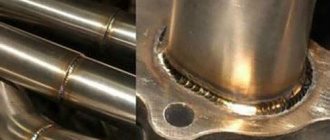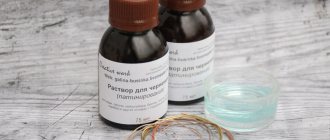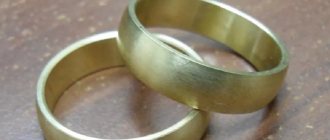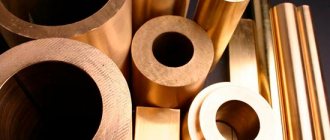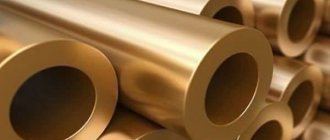Everyone has heard about brass: some people have ancient relics from their great-grandmothers at home, while others are fond of collecting beautiful antique items. The history of brass began before our era, which speaks of its usefulness and necessity for humanity. Then, in ancient times, brass was an alloy of copper with galmay (zinc carbonate). In Ancient Rome, this metal was called “golden copper” because of its similarity to gold; Coins were minted from brass: sesterces and duponies.
In addition to the nickname “golden copper”, brass was also called the “eternal” metal. This is explained by a number of unique features and technical properties that it possesses, as well as a wide scope of its use. But brass became what it is now in the 18th century thanks to James Emerson. It was he who, by combining copper with the metal zinc , officially obtained this alloy.
The “eternal” metal is similar to bronze and has similar technical properties and characteristics:
- resistance to long-term friction;
- melting fluidity;
- corrosion resistance.
Features of the alloy and principles of care
Brass is obtained by combining zinc and copper. The composition may also include other components: tin, nickel, aluminum, etc. The shade and properties of the metal will depend on the type of ligatures.
Adding zinc to the alloy began to be practiced in the 16th century. In Rome, compositions were made from copper and zinc ore, from which jewelry and dishes were made.
Brass is considered an eternal metal because... it practically does not wear out. Having bought a brass item once, you can use it for the rest of your life. Until recently, the ideal proportion of brass was the ratio of copper and zinc 1:2. Now the amount of Zn is reduced to 30% of the total mass. For technical alloys the percentage increases to 50%. The more zinc there is in a product, the cheaper it will cost.
Two-component types, where zinc makes up 20%, are used for the manufacture of automotive parts and thermal equipment. An alloy with 40% zinc is suitable for stamped brass products and fittings. Compositions with a large number of ligatures are used for various purposes. They are used to make pipes, watches, springs, souvenirs, etc.
What does brass look like?
Brass is also suitable for making jewelry. With a certain proportion of components, the alloy can be almost exactly similar to gold. Such jewelry visually resembles precious ones, but costs several times less.
Prevention
To keep things made of brass in perfect condition, it is enough to properly care for them and regularly clean them from dirt. When cleaning brass products, dust is removed, preventing it from accumulating in hard-to-reach places. A soft cloth is used to polish the surface of objects. This is necessary to maintain shine.
Things made of brass darken when exposed to sunlight. Therefore, they need to be stored in closed cabinets and drawers. Humidity is also harmful to this alloy, so the room where brass utensils, dishes or chandeliers are located must be periodically dried and ventilated. Cases lined with soft fabric on the inside are used to store jewelry.
Means and methods for cleaning alloys at home
Cleaning brass alloy begins with establishing its authenticity. There are metals that look like brass, but differ in composition. For them, it is necessary to select suitable cleaning products so as not to damage the surface. You can detect brass with a magnet. The alloy will not react to it.
By the way, a brass product does not always need cleaning. Sometimes a natural coating, on the contrary, gives them a noble appearance and increases their value. Once you have determined that the item is made of brass, you can clean it using one of the products.
Professional products
Specialized stores sell brass cleaning products, but when working with them you must follow safety precautions. Wear protective gloves, goggles, and a respirator.
- "Metalin" is a liquid containing 20% hydrochloric acid. Thanks to this, the brass product is effectively cleaned of any contaminants, including poorly soluble salt compounds. In addition, the drug contains inhibitors that create a reliable anti-corrosion layer on the surface, preserving the mechanical properties of the metal.
- “Delu” is an acidic preparation that copes with old stains from oxidation. During use, it emits harmful fumes, so it is necessary to protect the respiratory organs with a respirator.
- “Olex-2 Bronze Cleaner” is a paste-like, strongly acidic product for cleaning the alloy from oxide deposits and grease. After processing, a protective layer is created that prevents oxidation. Working with paste is very easy. Using a cotton swab, apply the product to the surface, wait 5-10 minutes and rinse off.
These cleaners will not only clean the surface, but also polish it.
Vinegar
Using vinegar, only newly formed stains are removed. To do this, it is heated and applied to the alloy. After a few minutes, wipe the surface with a sponge and rinse with clean water.
To clean old stains, mix 0.5 cups of vinegar with 2 liters of water and add a tablespoon of salt. The mixture is heated until it boils, the item to be cleaned is placed inside and boiled for several hours. As the water evaporates, it must be added. As a result of this procedure, dirt and dark spots will disappear. After this, the surface is wiped dry and polished.
Light soil removal products
If there are no persistent stains on the surface of brass items, but only slight darkening and dullness, you can use less aggressive cleaning agents. For example, to remove plaque, ketchup is used:
- First, wash the product in soapy water.
- Then rub the surface with ketchup with a sponge and leave for 20 minutes.
- Then remove the soaked dirt with a sponge and rinse the item with warm water.
Another mild brass cleaner is yogurt. It is poured into a pan and objects made of brass alloy are lowered into the liquid. After keeping them in the dairy product for an hour, the products are removed, washed with running water and dried with a towel.
You can clean brass thoroughly with baking soda and lime:
- Mix sodium bicarbonate half and half with water.
- Apply the paste to the surface of the object.
- Leave for 20 minutes.
- Cut a lime and rub a piece over the surface of the product.
- Leave for 40 minutes, then wash everything with water.
If the first attempt fails to achieve perfect cleanliness, the process is repeated again.
Nuances of updating the protective coating
The above methods for cleaning brass often result in a loss of its original appearance. To update the surface, you will have to remove the varnish layer and apply a new coating. Cleaning brass at home and renewing its coating is carried out according to the following principle:
- work is performed on a flat surface covered with plastic film;
- The old coating is removed with a brush dipped in acetone or nail polish remover.
- metal free from varnish is carefully polished with special pastes;
- Apply a new layer of varnish to the polished surface using a brush or cotton swab.
Varnishing a brass surface must be done very carefully so as not to leave fingerprints on it or damage it with long nails or the tools used.
After all the manipulations, the brass product will become like new and will delight you for a long time.
Copper and its production metal brass (a mixture of copper and zinc) are widely used in various spheres of human life and activity, including in everyday life. Door handles, figurines, teapots and coffee makers, copper strips and other household and interior items are often made of copper or brass, because these metals are not only aesthetic, but also practical. However, over time, the surface of products made of copper and its alloys may tarnish, and a specific coating may appear, which is the result of the interaction of brass and copper with the constituent elements of oxygen. Polishing brass is a simple process that can be done at home using available tools and removes oxides from the surface of copper alloys.
Tips for preventing tarnishing of brass
Following simple rules will help keep your products clean:
- do not touch the alloy object with dirty hands;
- Polish the product weekly with a soft cloth;
- be sure to wipe after washing - drops of water naturally dry into dark spots;
- keep brass jewelry in a closed box or casket;
- During storage, brass should not come into contact with other metals;
- avoid rooms with high humidity;
- Protect brass products from direct sunlight;
- Do not use abrasive products that may scratch the alloy.
Items such as door handles, which are most often exposed to adverse effects, are recommended to be coated with a protective layer of varnish. The best way to maintain the shine of brass that is constantly in contact with water (plumbing) is linseed oil, which is applied to faucets from time to time.
Simple folk methods of polishing brass and copper
Brass, as an alloy of copper and zinc, is not a capricious metal: it can be cleaned without resorting to industrial methods. As a polish for brass and copper, you can use available products that work well in cleaning copper alloys. You can use toothpaste, dishwashing detergent, and laundry soap - all these simple devices will help you return your copper items to their attractive appearance. However, if you intend to polish copper and brass to a mirror shine, then traditional methods of cleaning brass and copper can come to your aid.
Table salt and whey
In order to return copper and brass products to their original appearance, you can use the following mixture:
- whey – 200 ml;
- table salt – 1 tsp.
To polish brass, there is no need to immerse the piece in a solution. It is enough to moisten a small piece of rag and carefully treat the surface of an object made of copper or brass.
After polishing, brass and other copper alloys are thoroughly rinsed with cool running water. After this treatment, the product can be used immediately.
Lemon juice and table salt
Lemon juice and table salt in symbiosis can have an excellent cleansing effect on the surfaces of objects made of brass and other copper alloys. In order to put this method into practice, the lemon must be divided into two parts crosswise, and the cut areas must be sprinkled with salt. Holding half a lemon by the base, use the pulp to treat the problem areas of the copper.
After all manipulations, when the mixture of lemon juice and salt has corroded the oxide deposits, the product must be washed, wiped dry, and then polished with a small piece of soft cloth.
Polishing with ketchup
Oddly enough, the savory sauce works great for polishing brass and other copper alloys. To carry out the procedure, you will need a very small amount of ketchup.
Even the cheapest sauce can polish copper items.
Apply a small amount of ketchup to the item that needs polishing, distributing it evenly over the entire surface, leave for a few minutes to allow the destruction of the oxide components to occur.
Excess ketchup is removed with a cotton pad, sponge or cloth, after which the product must be thoroughly rinsed. This procedure will return the brass product to its original shine.
A mixture based on salt, vinegar and flour
To prepare a flour mixture for polishing copper alloys, including brass, you will need:
- vinegar - 1 glass;
- salt – 1 tbsp. l;
- flour – 2–3 tbsp. l.
First of all, salt must be mixed with vinegar in the prescribed proportions. Next, flour is added until a paste of medium viscosity is formed. The mixture can be used in two ways depending on the type of item:
- The dough must be applied to the brass product in a dense layer for 30–40 minutes, after which the surface is well brushed and washed.
- If the inside of a copper utensil needs polishing, the dough is placed directly on the bottom. The mixture must be distributed over the entire area that needs cleaning, after which the container is placed on medium heat. The vinegar and flour are boiled, after which the excess mixture is removed with a brush with stiff bristles.
In the first case, the effectiveness of the “flour” polishing method can be increased by adding a small amount of sawdust to the mixture.
Paste based on chalk and ammonia
To prepare the paste, you need to prepare the following components:
- ammonia solution 25%;
- crushed chalk (lime);
- water.
For 100 ml of water you will need 50 ml of ammonia solution and 20 g of chalk. The paste is applied to the surface of a product made of brass and other copper alloys for 20 minutes, after which it is treated with a high-strength brush and washed with water.
Small items such as coins are completely immersed in a solution of ammonia and chalk.
Using laundry soap
Laundry soap is an effective and economical way to return a brass or copper product to its original appearance of any size, provided there is no oxide.
The most effective ways
You can effectively clean brass using oxalic acid, which removes the most obsolete contaminants and oxides. However, it is recommended to use personal protective equipment (goggles and gloves). Step-by-step instruction:
- In a plastic container, mix 25 grams of the substance per liter of water.
- Wet a soft sponge in the solution and treat the alloy parts.
- Rinse the metal after 15 minutes under running water.
- Wash off the acid again with a solution of soap at a temperature of 30°C to 40°C.
Oxalic acid is found in many cleaning products. To remove traces of corrosion and rust, do the following:
- the solution is applied to the damaged area;
- wait up to 30 minutes, during which you can observe increased darkening of the contamination;
- carry out the treatment using brushes previously soaked in water;
- sprinkle the damaged area with baking soda and remove any remaining dirt with a rag;
- Rinse under water and wipe with a dry cloth.
Chemical and electrochemical polishing of copper and brass
Chemical and electromechanical polishing of copper and brass gives the most effective results, however, these methods are best used in an industrial environment, since the chemical reagents used during cleaning of brass can cause harm to the body.
Chemical polishing
Chemical polishing of copper alloys and other types of products involves placing the item in need of cleaning in a special container filled with a solution of various reagents and acids. The chemical is used to form specific reactions that have a destructive effect on unevenness, roughness and oxide deposits.
The copper product is kept in the solution for the time necessary for the chemical reaction to occur, after which it returns to its original attractive appearance.
Electrochemical polishing
Electropolishing of brass and copper parts is known for the high quality of restoring the surface of a metal product, obtaining a mirror surface and impeccable smoothness. Sulfuric or phosphoric acids most often act as a conductor of electricity.
The electrolyte is placed in a special bath with an additional layer of lead or polyethylene and heated to a temperature of 60–90 degrees Celsius. Lead cathodes are attached to parts made of copper alloys. The current density corresponds to 10–50 A/dm². The part should be treated in the electrolyte solution for approximately 5 minutes.
Precautionary measures
When cleaning brass items yourself using traditional methods or using special means, it is important to follow some rules:
- You need to clean brass at home on the surface of the slot, covered with oilcloth or waterproof film.
- During work, wear a protective suit, rubber gloves and a respirator. At the same time, gloves are needed not only to protect the skin of the hands. They protect the surface of soft metal from scratches.
- Means for cleaning brass items are selected taking into account the composition of the alloy.
It is not recommended to clean old antique items yourself. Restoration of such products is carried out by professionals. Improper use of cleaning products leads to damage to items.
Chemical composition
The alloy structure includes two elements - copper and zinc:
- Copper. This element belongs to the class of native minerals. It is distinguished by its flexibility and accessibility. This metal is among the first seven types of metals that have been known since ancient times.
- Zinc. The metal has a silvery-white color and has been known since ancient times. The substance received its modern name in the 20s. last century. The chemical properties of metal include brittleness and ductility. When exposed to air, zinc tarnishes, but at the same time it is resistant to corrosion.
Brass stands apart from other metals, despite the fact that it can easily be classified as a bronze, because their compositions and properties are identical. Its color depends on the concentration of zinc in the composition and can vary from greenish to gold. The peculiarity of brass is that this alloy does not have magnetic properties. To check whether it is a brass alloy, simply hold a magnet near it. If it does not succumb to magnetic influence, you have a brass product in front of you.
Rust removal
From time to time, bronze products become covered with a coating of corrosion. You can also defeat him with a slightly unusual reagent, which is ordinary yellow peas. There are two popular ways to use peas:
- The peas are boiled to a thick porridge. The resulting composition is used to cover the corrosion areas and leave until the mixture dries. Next, the dried pea paste is removed, the product is washed with plenty of water and thoroughly dried with napkins.
- The method is suitable for small things that fit in a pan. Several handfuls of peas are poured with water and brought to a boil. After boiling, the things that need to be cleaned are dipped into the broth and boiled over low heat for two to three hours. Next, the items are removed from the broth, washed with plenty of water and dried thoroughly. Pea particles are removed from uneven terrain with a soft brush.
Rust on bronze



